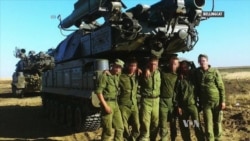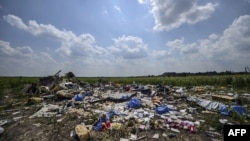A team of investigative journalists claims to have evidence showing that the missile that shot down a Malaysian airliner over Ukraine in July 2014 belonged to a Russian battalion that had recently deployed to the region. Two hundred ninety-eight people died when the flight from Amsterdam to Kuala Lumpur was downed. A Dutch-led Joint Investigation Team is still probing the crash.
Investigators from the website Bellingcat.com claim to have put together a mass of evidence pinpointing the origins of a specific Russian-made missile launcher - firing a so-called ‘BUK’ missile - that it claims was used to shoot down Malaysia Airlines Flight MH17.
Eliot Higgins, the founder of Bellingcat, told VOA via Skype his team was able to identify a number of individuals involved.
“Rather than talk about ‘this missile launcher has come from the Russian army’ and it’s all rather nebulous, we can say ‘these are the names and faces, these were the people who knew what was happening to this BUK missile launcher, who would have passed on the orders,” he said.
Distinctive markings
Higgins’ team collated videos of a military convoy in eastern Ukraine - posted on the Internet in the hours and days following the shooting down of flight MH17 - and identified a BUK launcher they believe fired the missile.
“Some of the photographs of the BUK missile launcher from July 17 in Ukraine, there’s marking visible on the side of the missile launcher that match perfectly with markings on the side of the missile launcher that was part of a convoy in Russia in June,” Higgins said.
Bellingcat then plotted the route of that June convoy in Russia, using videos posted online by soldiers and civilians filming from the roadside. It appears to have started at a military base close to Kursk, the home of the 2nd Battalion of Russia’s 53rd Air Defense Brigade, and ends close to the Ukrainian border.
“What we’ve been able to find is a vast number of social media accounts belonging to soldiers who were part of the 53rd Air Defense Brigade. And based on that we were able to piece together who they were, which members of the brigade were in that convoy,” said Higgins. “So they would have been people who would have seen this missile launcher, they would have seen it leave at some point; so these are key people for the investigation to be speaking to.”
Details passed to Dutch investigators
Bellingcat partly identifies the commander of the 2nd battalion as a man named ‘Dmitry T. - and names the overall commander of the 53rd Russian Air Defense Brigade as Colonel Sergey Borisovich Muchkaev. All details have been passed to Dutch investigators.
The Bellingcat investigation concludes that even if the BUK launcher was given to separatist forces in Ukraine, Russian soldiers were likely still present to advise on its operation.
Russia has consistently denied involvement - and at the time offered photographic and satellite evidence purporting to show that Ukrainian forces shot down the airliner. Ukraine dismissed the accusation, while Bellingcat says the Russian evidence was forged.







